Weekend Wanderlust: Scilla, the jewel of Italy's Violet Coast
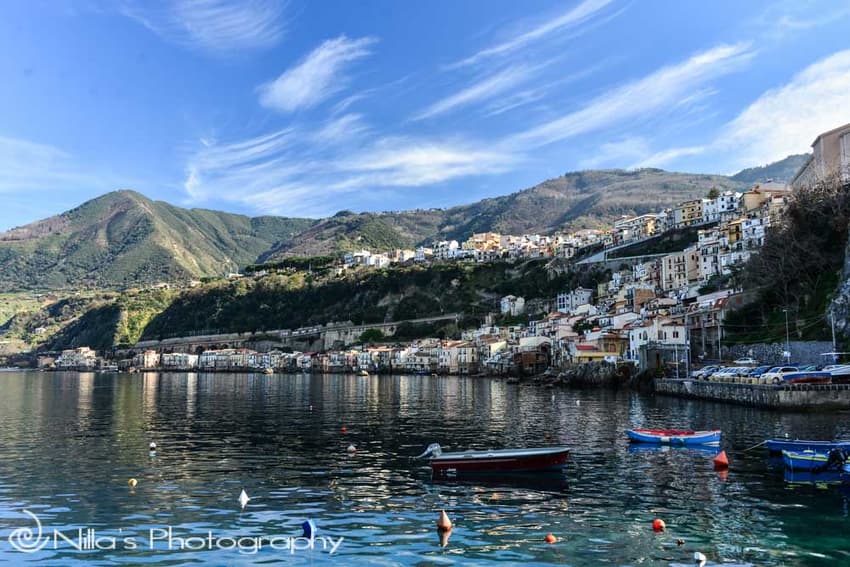
Nestled between a castle and cliffs lies Scilla, Reggio Calabria’s gorgeous fishing village. Travel blogger and photographer Nilla Palmer takes us on a tour.
I’m always amazed that there are rarely foreigners in this region. And to think that travellers are in a hurry to get down to Sicily as fast as possible, whilst bypassing this beautiful and untouched part of Italy.
Known as the Violet Coast for its sublime and dynamic colours, this really is a spectacular region of Italy, and one not to be missed. Although not too many foreigners visit this area, it is popular with Italians.
WEEKEND WANDERLUST:
-
Exploring Umbria by bike
-
How to visit Capri without breaking the bank
-
The perfect 24 hours in Bologna
Depending on how you arrive in Scilla, you land either in the beachfront Marina Grande or the fishing village of Chianalea. The areas are connected by a massive tunnelled archway and nestled on either side of the ancient Castello Ruffo.
Strategically perched high on a rocky outcrop overlooking the stunning Tyrrhenian Sea, this craggy promontory is steeped in history.
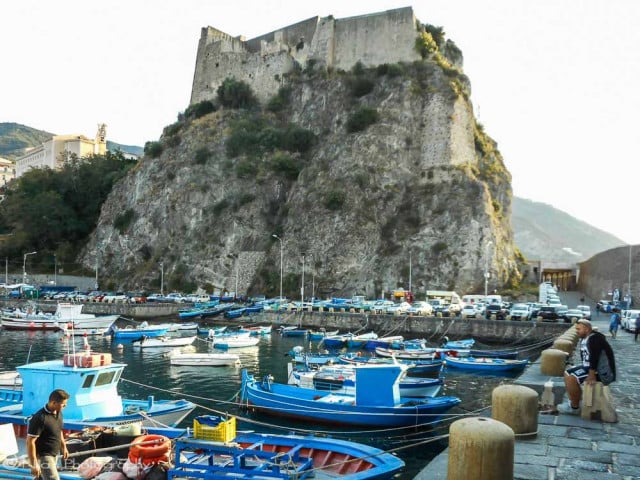
In Greek mythology, Scylla was Poseidon’s beautiful naiad (water nymph), who his jealous wife Amphitrite turned into a frightening sea monster by poisoning Scylla’s bathing spring. The fabled six-headed creature supposedly lured and drowned sailors trying to navigate the Messina Strait.
Scylla is also closely associated with Charybdis, which is a huge whirlpool – rather than a sea monster – off Sicily’s coast. Given the close proximity of the two, passing sailors were doomed either way, as to bypass Charybdis meant sailing too close to Scylla’s den. And so, there was no escape.
Take a peek up towards the northern end of Scilla. The promontory was believed to be the monster’s lair and is also known as ‘Scylla’s rock’. If you look closely, signs of the mythical monster are dotted around this village in colourful wall tiles, signs, a fountain, even tourist brochures.
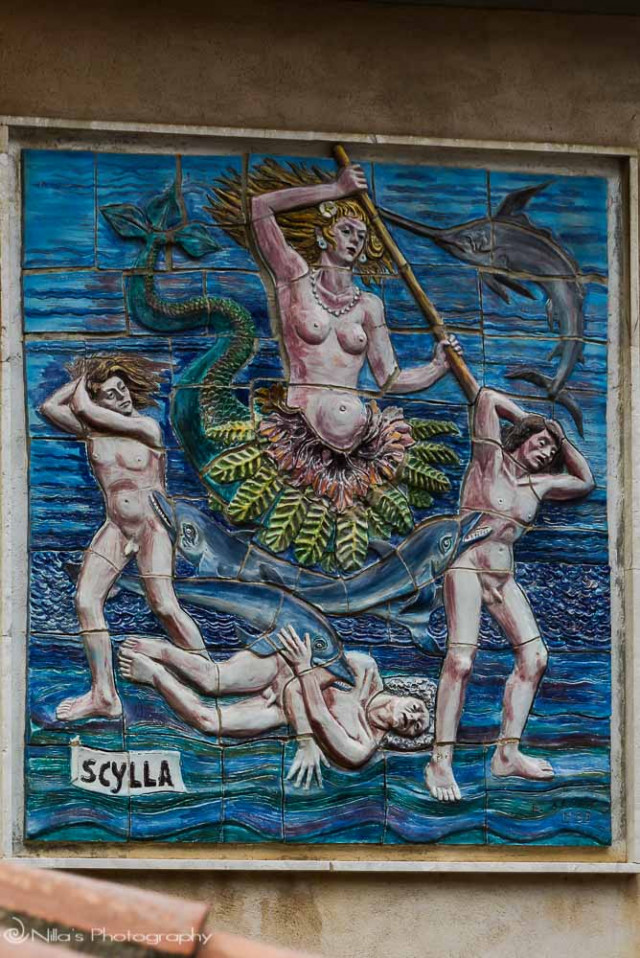
The imposing Castello Ruffo was built by the Dukes of Calabria with fortification commencing in the 5th century BC. In ancient times extremely skilled Tyrrhenian pirates dominated the Mediterranean routes, fighting local fishermen, with the pirates eventually driven out by the army of Anassila, the 'Tyrant of Reggio'.
The myriad of rocks and high fortress created an excellent natural refuge and an inaccessible place from which the pirates could conduct effective assaults along the coastline. This stretch also proved invaluable as a protected hiding place for spoils and a stronghold should a counterattack strike come.
The whole Strait of Messina was damaged in a 1783 earthquake. Sadly Castello Ruffo also succumbed but, after becoming state property in 1808, was restored in 1810. The castle lived later life as a monastery and a lighthouse, although today, it is a cultural centre for historic exhibitions, a conference centre and even hosts wedding functions.
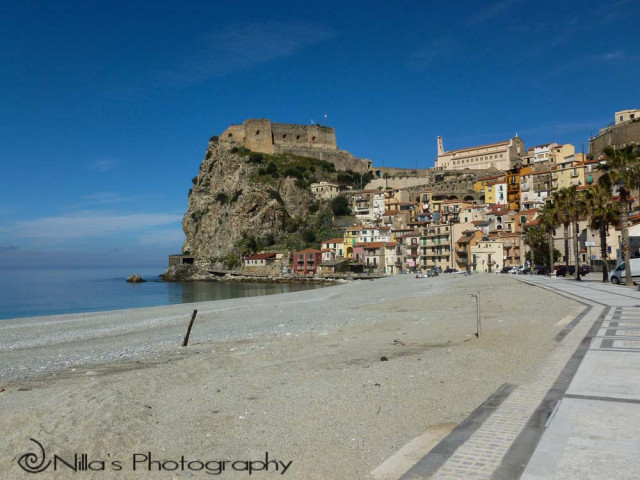
The ancient village of fishermen, Chianalea, is as colourful as it is enchanting and easily captivates your heart. Undulating sleepy cobbled lanes cascade directly into the Tyrrhenian Sea and are a delight to explore.
Wandering along the narrow laneways whilst gazing up to the amber and cinnamon-hued homes, delicately balanced against the rugged peninsula, is both relaxing and pleasant. Marvel at the engineering feat, with homes built literally on the sea’s rocky shoreline.
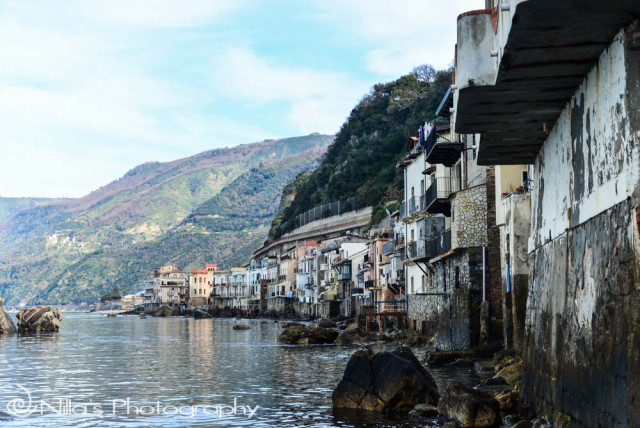
This Italian fishing village is famous for its swordfish and the harbour is dotted with brightly-coloured traditional fishing boats that don’t appear to have changed much through the centuries.
A walk to the end of Chianalea’s picturesque port and through some massive concrete arches has you descending down into Marina Grande and its kilometre-long beach: the Beach of Sirens.
The beach is extremely popular as a tourist destination during the summer months, though if visiting outside of July and August, you will have this relaxing stretch almost to yourself. Why not take a cooling dip in the sparkling clear sea? Or just while the hours away on the white sandy beach, before enjoying a refreshing spritz at sunset.
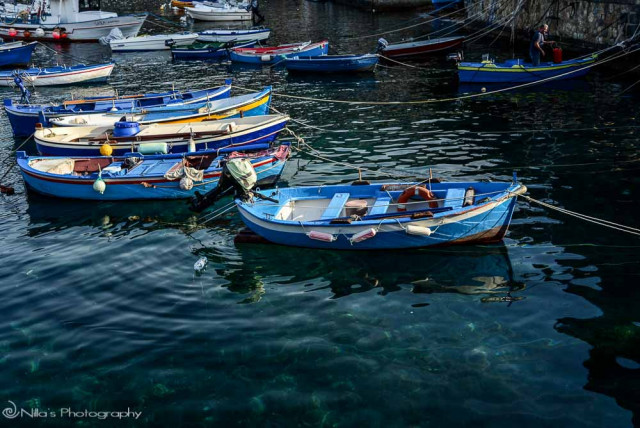
Getting there
If you’re on the train from the north, then stop at Scilla’s Marina Grande train station. From Cosenza, the Trenitalia trip is about three hours and follows the beautiful Tyrrhenian coast whilst snaking south to Italy's 'toe'.
Life is so much easier with a hire car. Driving from Cosenza in Calabria is straightforward on the E45 for under two hours. There are no tolls and the highway is in great shape in this part of Italy – a smooth ride. Park just before the huge tunnel as the parking meters never work, so you should be safe from getting a fine (but do check, just in case).
Travelling from Sicily, it is only about an hour’s drive from Messina to Scilla, if you time the ferry trip right. From the Calabria’s ferry side of Villa San Giovanni, the drive to the centre of Scilla is only about 8 kilometres.
Accommodation
Villa Grazia Scilla is an amazing home on three levels with a large garden that hugs the seashore. With stunning sea views from most rooms, this is a gorgeous hideaway.
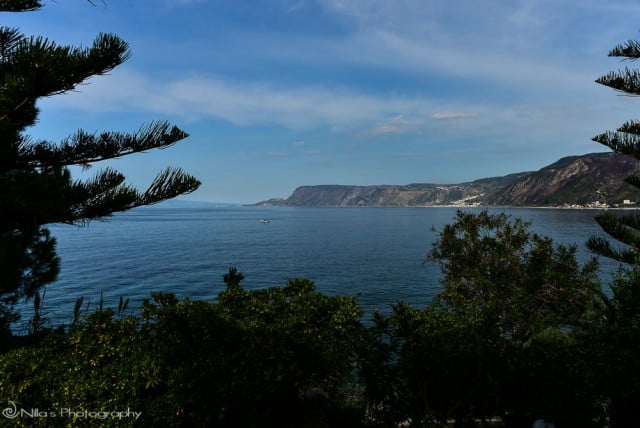
Grazia, the owner, came bearing gifts of fruit (even bergamot), vegetables, fresh walnuts and many local things for us to try, all grown from the garden at the house – so very kind are the people from this region.
Where to eat
Remember that in true Italian style, most places are closed anywhere from lunchtime to 8pm and especially out of the summer months.
San Francesco Bar Ristorante Pizzeria: this quaint little place is a great stop to savour an aperitivo whilst sitting outside and watching the locals go by on their daily walk along the seafront. Enjoy gorgeous views with good service at this locally run bar, which is open at lunchtime when many are closed.
Casa Vela Wine Bar: this B&B/restaurant opens early than most and prides itself on serving only delicious authentic Calabrese produce and wines. Facing the main ancient cobbled street, you can comfortably watch locals on their passeggiata (stroll) – a favourite Italian pastime – without being too obvious, whilst sipping your glass of vino or spritz.
Originally from Australia, Nilla Palmer has been in southern Italy for nearly three years. This is an edited version of a post that originally appeared on her blog, Image Earth Travel. Find more of her pictures at Nilla's Photography.
Would you like to contribute a guest post to The Local? Get in touch.
Comments (1)
See Also
I’m always amazed that there are rarely foreigners in this region. And to think that travellers are in a hurry to get down to Sicily as fast as possible, whilst bypassing this beautiful and untouched part of Italy.
Known as the Violet Coast for its sublime and dynamic colours, this really is a spectacular region of Italy, and one not to be missed. Although not too many foreigners visit this area, it is popular with Italians.
WEEKEND WANDERLUST:
- Exploring Umbria by bike
- How to visit Capri without breaking the bank
- The perfect 24 hours in Bologna
Depending on how you arrive in Scilla, you land either in the beachfront Marina Grande or the fishing village of Chianalea. The areas are connected by a massive tunnelled archway and nestled on either side of the ancient Castello Ruffo.
Strategically perched high on a rocky outcrop overlooking the stunning Tyrrhenian Sea, this craggy promontory is steeped in history.

In Greek mythology, Scylla was Poseidon’s beautiful naiad (water nymph), who his jealous wife Amphitrite turned into a frightening sea monster by poisoning Scylla’s bathing spring. The fabled six-headed creature supposedly lured and drowned sailors trying to navigate the Messina Strait.
Scylla is also closely associated with Charybdis, which is a huge whirlpool – rather than a sea monster – off Sicily’s coast. Given the close proximity of the two, passing sailors were doomed either way, as to bypass Charybdis meant sailing too close to Scylla’s den. And so, there was no escape.
Take a peek up towards the northern end of Scilla. The promontory was believed to be the monster’s lair and is also known as ‘Scylla’s rock’. If you look closely, signs of the mythical monster are dotted around this village in colourful wall tiles, signs, a fountain, even tourist brochures.

The imposing Castello Ruffo was built by the Dukes of Calabria with fortification commencing in the 5th century BC. In ancient times extremely skilled Tyrrhenian pirates dominated the Mediterranean routes, fighting local fishermen, with the pirates eventually driven out by the army of Anassila, the 'Tyrant of Reggio'.
The myriad of rocks and high fortress created an excellent natural refuge and an inaccessible place from which the pirates could conduct effective assaults along the coastline. This stretch also proved invaluable as a protected hiding place for spoils and a stronghold should a counterattack strike come.
The whole Strait of Messina was damaged in a 1783 earthquake. Sadly Castello Ruffo also succumbed but, after becoming state property in 1808, was restored in 1810. The castle lived later life as a monastery and a lighthouse, although today, it is a cultural centre for historic exhibitions, a conference centre and even hosts wedding functions.

The ancient village of fishermen, Chianalea, is as colourful as it is enchanting and easily captivates your heart. Undulating sleepy cobbled lanes cascade directly into the Tyrrhenian Sea and are a delight to explore.
Wandering along the narrow laneways whilst gazing up to the amber and cinnamon-hued homes, delicately balanced against the rugged peninsula, is both relaxing and pleasant. Marvel at the engineering feat, with homes built literally on the sea’s rocky shoreline.

This Italian fishing village is famous for its swordfish and the harbour is dotted with brightly-coloured traditional fishing boats that don’t appear to have changed much through the centuries.
A walk to the end of Chianalea’s picturesque port and through some massive concrete arches has you descending down into Marina Grande and its kilometre-long beach: the Beach of Sirens.
The beach is extremely popular as a tourist destination during the summer months, though if visiting outside of July and August, you will have this relaxing stretch almost to yourself. Why not take a cooling dip in the sparkling clear sea? Or just while the hours away on the white sandy beach, before enjoying a refreshing spritz at sunset.

Getting there
If you’re on the train from the north, then stop at Scilla’s Marina Grande train station. From Cosenza, the Trenitalia trip is about three hours and follows the beautiful Tyrrhenian coast whilst snaking south to Italy's 'toe'.
Life is so much easier with a hire car. Driving from Cosenza in Calabria is straightforward on the E45 for under two hours. There are no tolls and the highway is in great shape in this part of Italy – a smooth ride. Park just before the huge tunnel as the parking meters never work, so you should be safe from getting a fine (but do check, just in case).
Travelling from Sicily, it is only about an hour’s drive from Messina to Scilla, if you time the ferry trip right. From the Calabria’s ferry side of Villa San Giovanni, the drive to the centre of Scilla is only about 8 kilometres.
Accommodation
Villa Grazia Scilla is an amazing home on three levels with a large garden that hugs the seashore. With stunning sea views from most rooms, this is a gorgeous hideaway.

Grazia, the owner, came bearing gifts of fruit (even bergamot), vegetables, fresh walnuts and many local things for us to try, all grown from the garden at the house – so very kind are the people from this region.
Where to eat
Remember that in true Italian style, most places are closed anywhere from lunchtime to 8pm and especially out of the summer months.
San Francesco Bar Ristorante Pizzeria: this quaint little place is a great stop to savour an aperitivo whilst sitting outside and watching the locals go by on their daily walk along the seafront. Enjoy gorgeous views with good service at this locally run bar, which is open at lunchtime when many are closed.
Casa Vela Wine Bar: this B&B/restaurant opens early than most and prides itself on serving only delicious authentic Calabrese produce and wines. Facing the main ancient cobbled street, you can comfortably watch locals on their passeggiata (stroll) – a favourite Italian pastime – without being too obvious, whilst sipping your glass of vino or spritz.
Originally from Australia, Nilla Palmer has been in southern Italy for nearly three years. This is an edited version of a post that originally appeared on her blog, Image Earth Travel. Find more of her pictures at Nilla's Photography.
Would you like to contribute a guest post to The Local? Get in touch.
Join the conversation in our comments section below. Share your own views and experience and if you have a question or suggestion for our journalists then email us at [email protected].
Please keep comments civil, constructive and on topic – and make sure to read our terms of use before getting involved.
Please log in here to leave a comment.